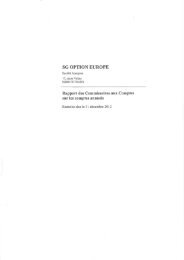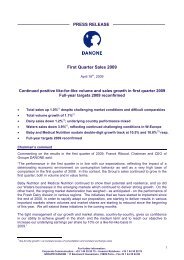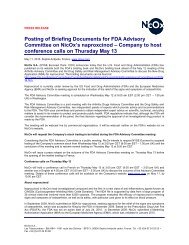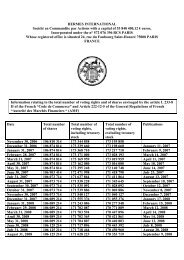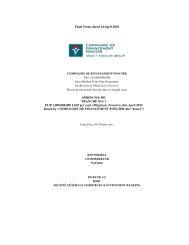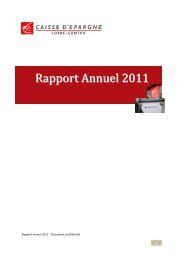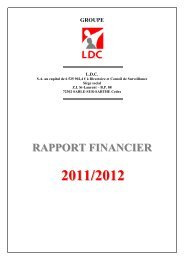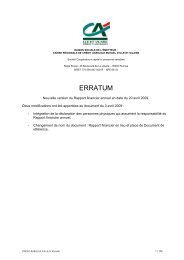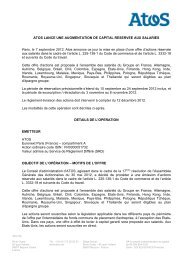Financial Reporting - Rexel
Financial Reporting - Rexel
Financial Reporting - Rexel
You also want an ePaper? Increase the reach of your titles
YUMPU automatically turns print PDFs into web optimized ePapers that Google loves.
These provisions also include costs of personnel disputes and tax litigation. A provision is not made for tax<br />
assessments received or in course of preparation when it is considered that the assessment is not justified or<br />
when there is a reasonable probability that the Group will succeed in convincing the authority of its position.<br />
Any accepted assessment is recorded as a liability when the amount can be reasonably estimated.<br />
2.17 | Sales<br />
Revenue arising from the sale of goods is presented in sales in the income statement. Sales are recognized<br />
when the significant risks and rewards of ownership have been transferred to the buyer, which usually occurs<br />
with the delivery or shipment of the product.<br />
Sales are recognized net of customer rebates and discounts.<br />
The Group may enter into direct sales (as opposed to warehouse sales) whereby the product is sent directly<br />
from the supplier to the customer without any physical transfer to and from the Group’s warehouse. The<br />
Group is acting as principal and therefore recognizes the gross amount of the sale transaction.<br />
2.18 | Other income and other expenses<br />
Operating income and expenses as a result of abnormal or unusual events are included as separate line<br />
items “Other income” and “Other expenses”. These line items include in particular, irrespective of their<br />
amount, gains and losses on asset disposals, asset depreciation, expenses arising from the restructuring or<br />
integration of acquired companies, separation costs, acquisition costs from business combinations and other<br />
items such as significant disputes. These items are presented separately in the income statement in order to<br />
allow <strong>Rexel</strong>’s Management Board, acting as Chief operating decision maker within the meaning of IFRS 8<br />
"Operating Segments", to assess the recurrent performance of the operating segments.<br />
2.19 | <strong>Financial</strong> expenses (net)<br />
<strong>Financial</strong> expenses (net) comprise interest payable on borrowings calculated using the effective interest rate<br />
method, dividends on preference shares classified as liabilities, interest receivable on funds invested,<br />
dividend income, foreign exchange gains and losses, and gains and losses on hedging instruments that are<br />
recognized in profit or loss (see note 2.10.5).<br />
Interest income is recognized in profit or loss as it accrues, using the effective interest rate method. Dividend<br />
income is recognized in profit or loss on the date the entity’s right to receive payment is established which in<br />
the case of quoted securities is the ex-dividend date. The interest expense component of finance lease<br />
payments is recognized in profit or loss using the effective interest rate method.<br />
2.20 | Income tax<br />
Income tax on the profit or loss for the periods presented comprises current and deferred tax. Income tax is<br />
recognized in profit or loss except to the extent that it relates to items recognized directly equity, in which<br />
case it is recognized in equity.<br />
Current tax is the expected tax payable on the taxable income for the year, using tax rates enacted or<br />
substantively enacted at the balance sheet date, and any adjustment to tax payable in respect of previous<br />
years.<br />
Deferred tax is provided using the balance sheet liability method, providing for temporary differences<br />
between the carrying amounts of assets and liabilities for financial reporting purposes and the amounts used<br />
for taxation purposes. The following temporary differences are not provided for: goodwill not deductible for<br />
tax purposes, differences relating to investments in subsidiaries to the extent that they will probably not<br />
reverse in the foreseeable future and the initial recognition of assets or liabilities in a transaction that is not a<br />
business combination and that affects neither accounting nor taxable profit. The amount of deferred tax<br />
provided is based on the expected manner of realization or settlement of the carrying amount of assets and<br />
liabilities, using tax rates enacted or substantively enacted at the balance sheet date.<br />
A net deferred tax asset is recognized only to the extent that it is probable that future taxable profits will be<br />
available against which the asset can be utilized. Deferred tax assets are reduced to the extent that it is no<br />
longer probable that the related tax benefit will be realized.<br />
38



